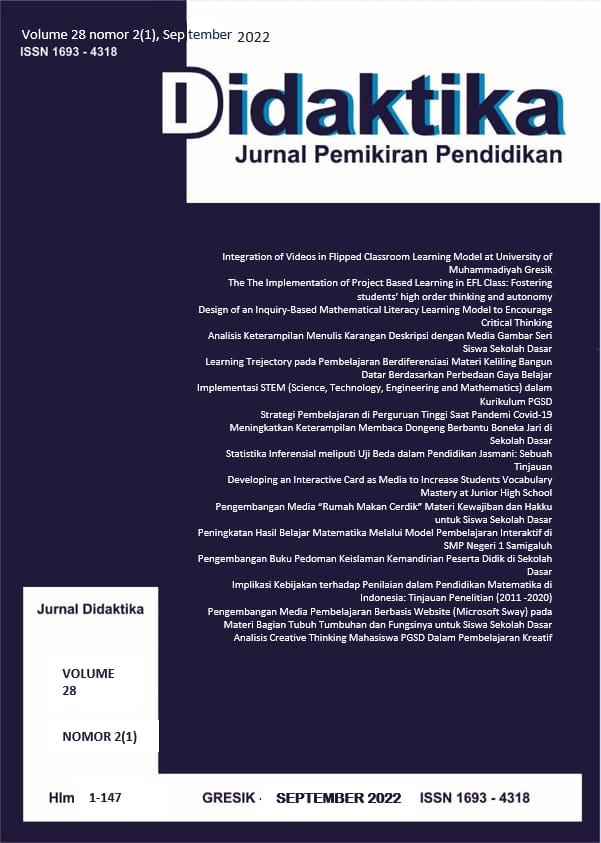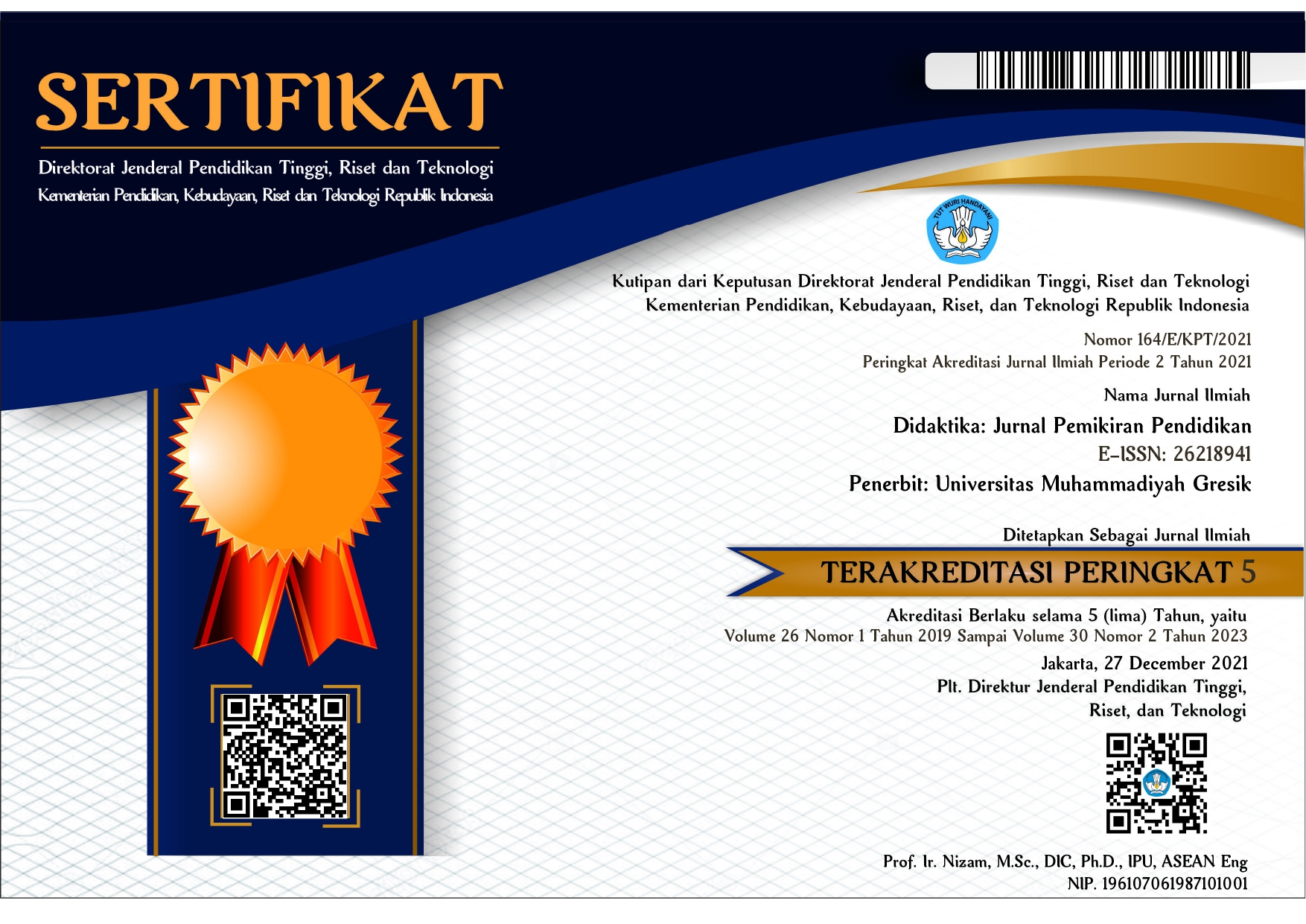Implementasi STEM (Science, Technology, Engineering and Mathematics) dalam Kurikulum PGSD
DOI:
https://doi.org/10.30587/didaktika.v28i2.4435Keywords:
STEM, PGSDAbstract
Penelitian ini bertujuan untuk mengeksplorasi ,dan menggali tentang pembelajaran berbasis pendekatan STEM untuk mahasiswa calon guru sekolah dasar. Pembelajaran STEM sangat diperlukan bagi kalangan pendidikan dasar mulai dari guru pada level dasar, siswa sekolah dasar dan mahasiswa calon guru sekolah dasar. Tujuan pembelajaran STEM adalah agar anak memiliki literasi sains yang tinggi serta mampu menggunakannya atau mengaplikasikannya dalam kehidupan sehari-hari. Penggalian ini diperlukan karena keikutsertaan negara Indonesia melalui pengukuran PISA, selalu menempatkan Indonesia pada peringkat bawah dalam pengukuran literasi sains, matematika dan Bahasa. Dengan program studi yang memiliki produk pembelajaran berbasis STEM maka akan mampu menyiapkan dan membekali calon lulusannya untuk menjadi calon guru SD yang memiliki bekal kemampuan akademik dan keterampilan dalam mengemas pembelajaran sains di SD berdasarkan STEM. Sehingga mampu memberikan kontribusi dalam peningkatan literasi sains dan matematika untuk anak-anak SD di tempat mereka bertugas.
References
Arikunto. (2010). Suharsimi Arikunto.pdf. In Prosedur Penelitian Suatu Pendekatan Praktik-Revisi ke X.
Astuti, I. D., Toto, T., & Yulisma, L. (2019). MODEL PROJECT BASED LEARNING (PjBL) TERINTEGRASI STEM UNTUK MENINGKATKAN PENGUASAAN KONSEP DAN AKTIVITAS BELAJAR SISWA. Quagga: Jurnal Pendidikan Dan Biologi, 11(2). https://doi.org/10.25134/quagga.v11i2.1915
Becker, K. And Park, K. (2011). “Effects of integrative approaches among, STEM subjects on students learning.” Journal of STEM Education.
Fathoni, A., Muslim, S., Ismayati, E., Rijanto, T., Munoto, & Nurlaela, L. (2020). STEM : Inovasi Dalam Pembelajaran Vokasi. Jurnal Pendidikan Teknologi Dan Kejuruan, 17(1).
Komarudin, U., Rustaman, N. Y., & Hasanah, L. (2017). Promoting students’ conceptual understanding using STEM-based e-book. AIP Conference Proceedings, 1848. https://doi.org/10.1063/1.4983976
Melati, L. T. (2019). Pengaruh Model Problem Based Learning Berbasis Stem Terhadap Penguasaan Konsep Dan Kemampuan Berpikir Kritis Siswa. Bioed: Jurnal Pendidikan Biologi.
Mendelsohn, M. L., Gathmann, A., Kardassi, D., Sachana, M., Hopwood, E. M., Dietz-Pfeilstetter, A., Michelsen-Correa, S., Fletcher, S. J., & Székács, A. (2020). Summary of Discussions From the 2019 OECD Conference on RNAi Based Pesticides. Frontiers in Plant Science. https://doi.org/10.3389/fpls.2020.00740
Miles, M., & Huberman, A. (2014). Miles and Huberman. In Qualitative Data Analysis: An expanded sourcebook.
Nieveen, N., & Folmer, E. (2013). Formative evaluation in educational design research. Educational Design Research. Part A: An Introduction.
OECD. (2016). OECD Factbook 2015/2016 - Economic, environmental and social statistics. In OECD Publishing.
Oner, A., Nite, S., Capraro, R., & Capraro, M. (2016). From STEM to STEAM: Students’ Beliefs About the Use of Their Creativity. STEAM. https://doi.org/10.5642/steam.20160202.06
Pangesti, K. I., Yulianti, D., & Sugianto. (2017). Bahan Ajar Berbasis STEM (Science, Technology, Engineering, and Mathematics) untuk Meningkatkan Penguasaan Konsep Siswa SMA. Unnes Physics Education Journal, 6(3).
Pranita, M. Y., Wisodo, H., & Yuliati, L. (2019). Penguasaan Konsep Peserta Didik pada Materi Usaha dan Energi melalui Pembelajaran Authentic Berbasis Inquiry for STEM Education. Jurnal Pendidikan: Teori, Penelitian, Dan Pengembangan, 4(6). https://doi.org/10.17977/jptpp.v4i6.12481
Ramli, N., & Talib, O. (2017). Can Education Institution Implement STEM? From Malaysian Teachers’ View. International Journal of Academic Research in Business and Social Sciences.
Reyza, M., Taqwa, A., Ardiansyah, A. A., & Nurhidayat, M. A. (2020). INDONESIAN JOURNAL OF EDUCATIONAL RESEARCH AND REVIEW STEM on Science Learning in Indonesia: An Opportunity and A Challenge. Ejournal.Undiksha.Ac.Id, 3.
Rivai, H. P., Yuliati, L., & Parno. (2018). Penguasaan konsep dan kemampuan pemecahan masalah konseptual dengan pembelajaran STEM berbasis masalah materi fluida dinamis pada siswa SMA Negeri 3 Batu / Helmi Pakas Rivai. Jurnal Pendidikan: Teori, Penelitian, Dan Pengembangan, 3(8).
Sagala, R., Umam, R., Thahir, A., Saregar, A., & Wardani, I. (2019). The effectiveness of stem-based on gender differences: The impact of physics concept understanding. European Journal of Educational Research, 8(3). https://doi.org/10.12973/eu-jer.8.3.753
Sanders, M. (2009). STEM, STEM education, STEMmania. The Technology Teacher.
sugiyono. (2010). Metode Penelitian kualitatif dan kuantitatif.
Torlakson, T. (2014). INNOVATE: A Blueprint for Science, Technology, Engineering, and Mathematics in California Public Education. In California Department of Education.
Widya, Rifandi, R., & Laila Rahmi, Y. (2019). STEM education to fulfil the 21st century demand: A literature review. Journal of Physics: Conference Series. https://doi.org/10.1088/1742-6596/1317/1/012208
Downloads
Published
How to Cite
Issue
Section
License
License and Copyright Agreement
In submitting the manuscript to the journal, the authors certify that:
- They are authorized by their co-authors to enter into these arrangements.
- The work described has not been formally published before, except in the form of an abstract or as part of a published lecture, review, thesis, or overlay journal.
- That it is not under consideration for publication elsewhere,
- That its publication has been approved by all the author(s) and by the responsible authorities – tacitly or explicitly – of the institutes where the work has been carried out.
- They secure the right to reproduce any material that has already been published or copyrighted elsewhere.
- They agree to the following license and copyright agreement.
Copyright
Authors who publish with DIDAKTIKA: Jurnal Pemikiran Pendidikan agree to the following terms:
- Authors retain copyright and grant the journal right of first publication with the work simultaneously licensed under a Creative Commons Attribution License (CC BY-SA 4.0) that allows others to share the work with an acknowledgment of the work's authorship and initial publication in this journal.
- Authors are able to enter into separate, additional contractual arrangements for the non-exclusive distribution of the journal's published version of the work (e.g., post it to an institutional repository or publish it in a book), with an acknowledgment of its initial publication in this journal.
- Authors are permitted and encouraged to post their work online (e.g., in institutional repositories or on their website) prior to and during the submission process, as it can lead to productive exchanges, as well as earlier and greater citation of published work.
Licensing for Data Publication
Open Data and Software Publishing and Sharing
The journal strives to maximize the replicability of the research published in it. Authors are thus required to share all data, code or protocols underlying the research reported in their articles. Exceptions are permitted but have to be justified in a written public statement accompanying the article.
Datasets and software should be deposited and permanently archived inappropriate, trusted, general, or domain-specific repositories (please consult http://service.re3data.org and/or software repositories such as GitHub, GitLab, Bioinformatics.org, or equivalent). The associated persistent identifiers (e.g. DOI, or others) of the dataset(s) must be included in the data or software resources section of the article. Reference(s) to datasets and software should also be included in the reference list of the article with DOIs (where available). Where no domain-specific data repository exists, authors should deposit their datasets in a general repository such as ZENODO, Dryad, Dataverse, or others.
Small data may also be published as data files or packages supplementary to a research article, however, the authors should prefer in all cases a deposition in data repositories.











